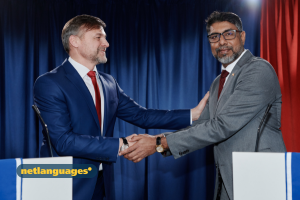Body Language: What we say without words
When world leaders meet, people often look carefully at their body language. Journalists often focus on their handshakes, the way they sit and the way they smile. Many believe that these actions, more than words, can tell us how people really feel about each other.
Our body language - using our face, hands, and body - sends messages without speaking. A smile usually shows friendliness or happiness, but not always. In some countries, people smile when they are nervous, or even when they want to hide how they really feel. Shaking hands is common in many Western countries. It is a normal way to say “hello,” and a strong handshake often shows confidence. But in other countries, like Japan, people may bow instead. This can feel strange to people from outside the culture, but it shows respect.
Even simple things can be different. In many places, nodding your head means “yes,” but in countries like Bulgaria, the same action actually means “no.” Imagine how confusing that can be! A wave might mean “hello” in one place, but in another it could mean “go away.”
This shows that body language is not the same everywhere. When you meet people from other cultures, it is important to notice these small differences. Understanding them can make travel, study, and international friendships much easier. Learning a language is also about learning these hidden cultural messages.
